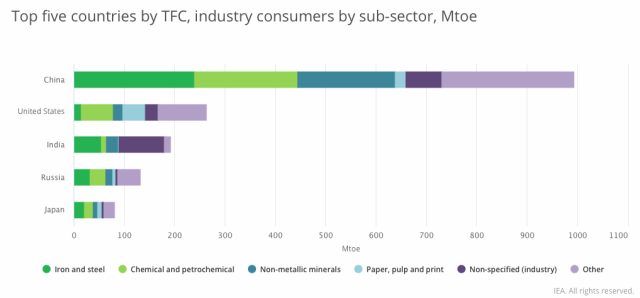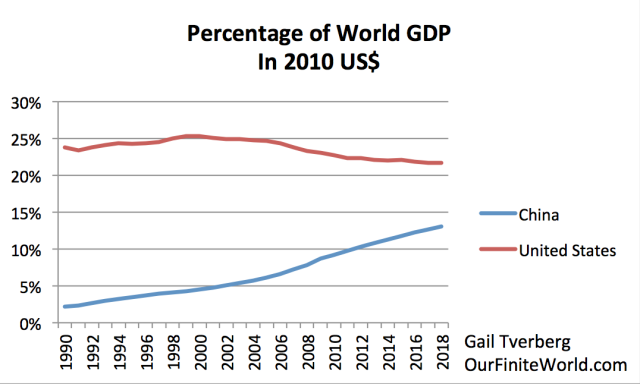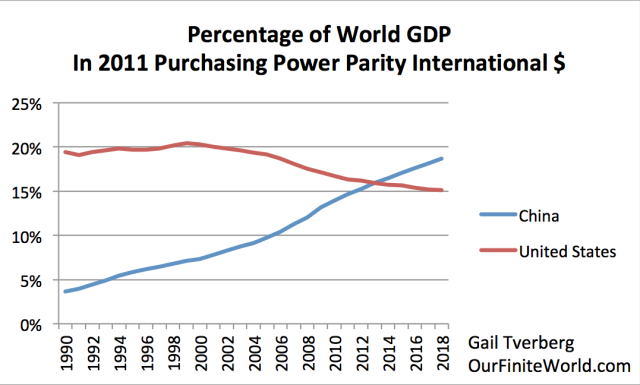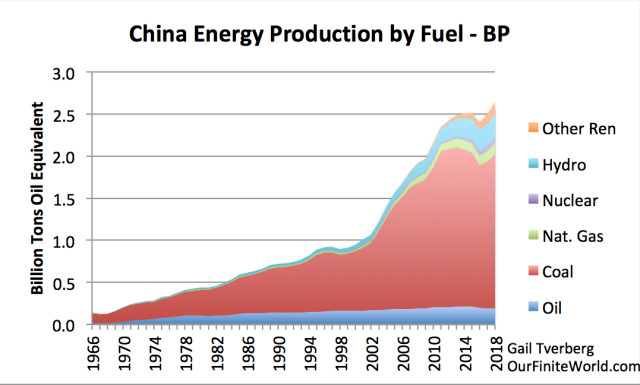Tverberg: It Is Easy To Overreact To The Chinese Coronavirus
Authored by Gail Tverberg via Our Finite World blog,
Recently, a new coronavirus has been causing many illnesses and deaths. The virus first became active in Wuhan, China, but it has already spread to the rest of China. Scattered cases have been identified around the rest of the world as well.
There are two important questions that are already being encountered:
-
How much of an attempt should be made to limit the spread of the new virus? For example, should businesses close to prevent the spread of the virus?
-
Should this disease be publicized as being far worse than flu viruses that circulate each year and cause many deaths among the elderly and people in poor health? The median age of those dying from the new coronavirus seems to be about 75.
Unfortunately, there aren’t easy answers. We can easily see the likely outcome of under reaction. More people might die of the disease. More people might find themselves out of work for a couple of weeks or more with the illness. We tend to be especially concerned about ourselves and our own relatives.
The thing that is harder to see is that reacting too vigorously can have a hugely detrimental impact on the world economy. The world economy depends on international trade and tourism. China plays a key role in the world economy. Quarantines of whole regions that last for weeks and months can have a very detrimental impact on the wages of people in the area and profits of local companies. Problems with debt can be expected to spike. The greater the reaction to the coronavirus, the more likely the world economy will be pushed toward recession and job loss.
The following are a few of my thoughts regarding possible overreaction:
[1] The Chinese coronavirus seems to be extremely contagious, even before a person who has been exposed shows any symptoms. The only way we can be certain to contain the virus seems to be through quarantines lasting up to 14 days.
China’s National Health Minister, Ma Xiaowei, has provided information that seems quite alarming. With the new virus, a person may become communicable shortly after he/she has been infected, but symptoms may not appear for up to 14 days. This allows the infected person to infect many others without realizing that he/she is a carrier for the disease.
Today, the United States and many other countries screen for the virus by checking passengers arriving on planes from affected areas for fevers. Given the information provided by China’s National Health Minister, this approach seems unlikely to be sufficient to catch all of the people who may eventually come down with the disease. If a country really wants to identify all the potential carriers of the disease, it appears that a 14-day quarantine for all travelers from infected areas may be needed.
Such a quarantine becomes administratively difficult to handle for the huge number of people who are likely to travel from China. Such a quarantine would make it impossible for pilots and other airline workers to make a living, for example. They would be spending too much of their time in quarantine to do the work needed to support themselves and their families.
A related concern is that person-to-person transmission is very easy with the Chinese coronavirus. We don’t know for certain how many people each infected individual infects, but one estimate is that each infected person transmits the disease to an average of 2.5 other people. With this transmission rate, the number of people having the disease can be expected to grow exponentially, perhaps for several months.
Based on these concerns, it seems to me that funds spent on trying to contain the coronavirus are likely to be largely wasted. The new Chinese virus will spread widely, regardless of attempts to contain it. At most, quarantines will slightly slow the transmission of the disease. At the same time, quarantines will be quite disruptive of commerce. They will tend to reduce both total wages and total output of goods and services of the area.
[2] Deaths from pathogens are part of the natural cycle. They help prune back the population of the old and weak.
We know that in ecosystems, one of the functions of naturally occurring fires is to clear out “deadwood,” to allow healthy new growth to occur. In fact, some types of seeds seem to require smoke for germination. When inadequate natural burning takes place, bushfires as seen in Australia and forest fires as seen in California become an increasing problem.
Deaths from pathogens seem to play a similar role in human economies. This is especially the case with pathogens that especially target the weak and old. Most flu viruses have this characteristic. Early reports of deaths from the coronavirus suggest that this same pattern of targeting the old and weak is occurring with this virus as well. As noted above, the median age of those dying from the new coronavirus seems to be about 75 years.
Since the 1940s, modern medicine has been able to develop antibiotics and vaccines to counteract the impact of many pathogens. This, of course, makes citizens happy, but it has the disadvantage of changing the population in a way that leaves the economy with a much higher percentage of elderly people and others in poor health. This higher level of elderly and medically needy people makes it easy for viruses and other pathogens to make their rounds, just as leaving deadwood on the forest floor makes it easier for fires to spread.
With this rising population of people who cannot support themselves, tax rates for the remaining citizens tend to become very high. Young workers may become discouraged because they do not have enough income remaining after paying taxes to raise their own families. In effect, they cannot support both their young families and the many old people.
Viewed from this unusual perspective, the operation of the Chinese coronavirus might even be considered a benefit to society as a whole. The world has overcome the impact of measles, typhoid, polio, and many other diseases. In some sense, it “needs” a new disease added to its portfolio, to replace the ones that have been mostly taken care of by modern medicine. In this way, pensions and other payments targeting the old and weak don’t become too great a burden on the young.
[3] If the Chinese coronavirus were simply allowed to run its course, without publicity that it was in any way unusual, somewhat less than 1% of the world’s population might be expected to die.
To see what would happen if the Chinese coronavirus were to run its course, we might look at what happened with the Spanish Flu, back in 1918. At that time, doctors did not have a way of treating the virus and authorities downplayed concern for the disease. The US Center for Disease Control reports that 500 million people, or one-third of the world’s population, became infected. At least 50 million people (about 10% of those infected) died.
We don’t yet know with accuracy how many of those infected will die from the current virus. A recent estimate is that about 2.3% of those who are infected will die of the disease (based on 107 dying out of 4,600 infected). If we assume that the percentage of the population that will ultimately catch the new virus is 30%, then the share of the world’s population that would be expected to die would be about [(1/3) x 2.3% = 0.76%].
The UN estimates that the world’s population can be expected to grow by about 1.05% in 2020. If this is the case, the effect of the Chinese virus would be to sharply dampen the population increase for the year. Instead of population rising by 1.05%, it would rise by only 0.29% (= 1.05% – 0.76%), assuming all of the deaths associated with the Chinese coronavirus take place within a year. While this would be a change, it would be a fairly small, temporary change.
All of these deaths would be tragic for the families involved but, in a way, they would be less of a problem than the deaths that took place back in 1918. At that time, mortality was high for healthy 20 to 40 year olds, making the flu particularly disruptive for families. The total percentage of the population that died was also much higher, about 3% instead of 0.76%.
[4] A major danger of the virus seems to be one of overreaction.
Today’s world economy is fragile. China, like other countries, has a large amount of debt. Debt defaults related to poor profits of companies closing their operations for a time and workers losing income could easily skyrocket.
Closing down transportation from China would risk pushing the world economy into a very bad recession. In fact, simply having a very large number of people out sick from work would be expected to have an adverse impact on the economy. Spending a large amount of money on hospitalizations and face masks cannot compensate for the loss of productivity of the rest of the economy. Thus, the tendency would be toward recession in China, even if no action toward cutting off travel were taken.
China is a huge supplier of goods to the rest of the world. In fact, in 2016, it used more energy in producing industrial output than the United States, India, Russia and Japan combined.
Figure 1. Chart by the International Energy Agency showing total fuel consumed (TFC) by industry, for the top five fuel consuming nations of the world.
China’s economy has been growing very rapidly since 1990. Figure 2 shows this one way, in GDP comparisons using inflation-adjusted US dollars.
Figure 2. GDP of China and the United States, computed as percentages of World GDP. All amounts in 2010 US dollars, as provided by the World Bank.
Figure 3 is similar to Figure 2, except the growth comparison is made in “2011 Purchasing Power Parity International Dollars.” This adjustment is made because typically the currencies of less developed nations float far below the dollar, in terms of what the local currency will buy. The inflation-adjusted PPP comparison compares output on a basis that is expected to be more consistent with what the local currency will really purchase.
Figure 3. Ratios of the GDP of China and the United States to the World GDP. All amounts in 2011 Purchasing Power Parity International Dollars, as provided by the World Bank.
On this PPP basis, China’s GDP surpassed the US’s GDP in 2014. Figure 3 also shows that the United States has slipped from about 20% of the world’s GDP to about 15% on this basis.
We cannot simply cut off trade with China, regardless of how bad the situation is. China is too big and too important now. The rest of the world desperately needs goods and services produced in China, in spite of what is going wrong from an illness perspective. China plays too key a role in supply chains of many kinds for the country to be left out.
Even cutting off tourism becomes a problem. The share of China’s revenue from tourism amounted to 11% in 2018. While not all of this would drop off, even a dip would lead to lower employment in this part of its economy. Jet fuel use would drop as well.
[5] A particular problem today is low prices for many commodities, including oil and other fossil fuels. These prices are likely to fall further, if China’s economy falters further.
We used to hear that the world would “run out of” oil and that oil prices would rise very high. In fact, if the people who were concerned about the issue had studied history, they would have figured out that a far more likely outcome would be “collapse.” In such a situation, prices of many commodities might fall too low. Revelation 18:11-13 provides a list of a number of commodities, including humans sold as slaves, for which prices dropped very low at the time of the collapse of ancient Babylon.
The problem is a different squeeze than a high-price squeeze. It is more of a growing wage disparity problem, with fewer and fewer of the world’s workers being able to afford the goods and services made by the world economy. This problem feeds back to commodity prices that fall too low for producers of many types. The problem is an affordability issue, rather than one of running out. I have written about this issue many times.
Prices of fossil fuels have been low for a very long time–essentially since late 2014. OPEC has cut back its oil production because of low oil prices. Several US natural gas producers have taken big write offs on natural gas investments. China’s coal production has remained below its 2013 level, because of low prices.
Figure 4. China energy production by fuel, based on 2019 BP Statistical Review of World Energy data. “Other Ren” stands for “Renewables other than hydroelectric.” This category includes wind, solar, and other miscellaneous types, such as sawdust burned for electricity.
If China finds it necessary to cut back on production of goods and services for any reason (excessive sickness within China, visitors aren’t traveling to China, tariffs, customers around the world aren’t buying cars), this reduction in output would be likely to further lower the prices of commodities. More producers would go bankrupt. Countries exporting products as diverse as oil, iron ore, copper and lithium might have economic difficulties.
Lower fossil fuel prices may lead to a cutback in their output, but it is doubtful that this cutback would be offset by an increase in the production of renewables. Falling fossil fuel prices would make the price comparison of renewables to fossil fuels look even worse than it does today. China has cut back on its subsidies for solar panels, and this has led to decreasing Chinese solar installations in both 2018 and 2019.
[6] The best approach might just be to let the Chinese coronavirus run its course. Authorities might also discourage stories about how awful the illness is.
Today, we seem to think that we can fix all problems. Unfortunately, this medical problem doesn’t seem to be fixable in the near-term. We should probably do as governments through the ages have done, which is not very much. We should not publicize the disease as being a whole lot worse than flu viruses in general, for example.
We should certainly look for inexpensive treatments for the disease. For example, there seems to be an effort to examine the possibility of using existing antiviral drugs as a treatment. It seems like an effort could be made to look into ways of treating the disease at home, perhaps using supplemental oxygen for a period. In time, perhaps a vaccine can be developed.
Individuals around the world should be encouraged to get themselves in as good health as possible, so that their own immune systems can fight off pathogens of all types, not just this particular virus. Common sense should be used in washing hands and in avoiding being with sick people. I doubt that it makes sense to encourage the use of masks, goggles and other protective devices.
We, as individuals, cannot live forever on this earth. We also cannot spend an unlimited percentage of GDP on health care: It becomes too high-cost for most citizens. At some point, we need to call a halt to the expectation that we can fix all problems. We live in a world with limited resources. We need to start lowering our expectations, if we don’t want to make our problems worse.
https://ift.tt/2u4onpm
from ZeroHedge News https://ift.tt/2u4onpm
via IFTTT








0 comments
Post a Comment